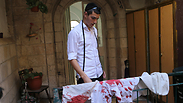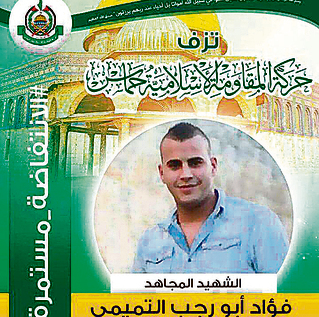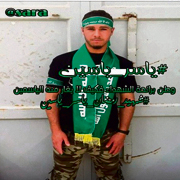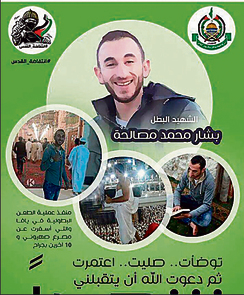
'This isn't a lone wolf intifada, it's a Hamas intifada'
New study by terrorism expert claims that Israel is not dealing with individual attackers, but rather a coordinated effort led by Hamas, which is an expert in covering its tracks. The defense establishment, however, is still convinced this is an intifada of 'lone wolves.'
Bashar Mohammed Masalha is a 22-year old "lone wolf" attacker according to the Shin Bet, the IDF, and the police. Masalha, an illegal alien in Israel from the Palestinian village of Haja near Qalqiliya, went on a stabbing spree on Tuesday evening from Jaffa Port to the promenade, wounding eleven people and killing an American tourist.
Abd al-Rahman Radad from the West Bank village of Al-Zawiya near Tulkarm stabbed a yeshiva student in Petah Tikva on the same day, and is also a "lone wolf" attacker according to the security services' definition. So are Fuad Abu Rajab al-Tamimi from the East Jerusalem neighborhood of Issawiya, who shot two police officers in East Jerusalem, and Fadwa Abu Tir, who attempted to stab Border Police officers that same morning in the Old City.
Four terrorists, apparently with no organizational affiliation, that nobody sent, in another bloody day of the third intifada - the intifada of the lone wolves.
Except that last Tuesday was not just another coincidental day of blood spilling in the ongoing wave of terror attacks. On March 8, 2003, Israel assassinated Dr. Ibrahim al-Makhadmeh, who was sitting in his car in the Sheikh Radwan neighborhood of Gaza with three other Hamas terrorists. It was a major blow to the terror organization because al-Makhadmeh, a dentist, was one of Hamas’ founders and most prominent ideologues, second only to Ahmad Yassin.
Al-Makhadmeh is the one who wrote that armed resistance is the only path to independence “even if it costs the death of half of the Palestinian nation.” Hamas leader Ismail Haniyeh also mentioned him in his speech last Tuesday, and in the same breath praised the terrorists for their contribution to the Palestinian struggle. And, indeed, the Facebook pages of two of the terrorists, as well as other findings, prove that Haniyeh had good reason to refer to them as martyrs on behalf of Hamas. And indeed, after the Tuesday attacks, Hamas published four identical statements on Facebook blessing and praising “its martyred sons and daughters.”
A look at Masalha’s Facebook page, shows he shared Hamas content and expressed solidarity with the Islamic movement long before he carried out the attack in Jaffa; that he was very religious and on on February 28 performed the Umra (a pilgrimage to Mecca that is not done during a Hajj); that he loved the "Mourabitoun" (literally, those who hold the fort), members of that organization which is affiliated to Hamas, who would sacrifice their lives for the land of Palestine. On the night of the attack, he wrote, “We are in our holy land and we do not fear our enemy or its force.”
One of the members of the Mourabitoun is Fadwa Abu Tir, a relative of the orange-bearded Mohammed Abu Tir, who ran as Hamas’ second candidate for the Palestinian Legislative Council in January 2006. Sheikh Kamal Khatib, the deputy head of the Northern Branch of the Islamic movement in Israel, said that she died while fulfilling her duty as a woman on International Women’s Day.
Seventeen-year-old Radad, who carried out the attack in Petah Tikva, comes from a family that has been affiliated with Hamas for many years. Two other Radads were arrested: Muatasem Radad was sentenced to 20 years in prison for planning a terror attack, and Iyad Radad carried out a suicide attack on Allenby Street in Tel Aviv in September 2002. Hamas claimed responsibility for the Allenby Street attack six years later, in accordance with policies outlined in a Hamas document on "lone wolf" attacks.
This book-length document written by Rajeb Hassan Al-Baba summarizes the principles for carrying attacks with "the white weapon"- a code name for knife attacks. It says, “Attacks should have the characteristics of a lone wolf attack.” It continues, “One who carries out an individual attack, should work on his own and not consult with anyone beforehand. Moreover, the knife used to stab the enemy should be obtained from the attacker's house or from a store.” The document, which details what appear to be instructions for terrorists on how to carry out stabbing attacks, is available on Hamas’ website. "This system of operations," the author of the document notes, “would ensure that the Shin Bet and Israeli security services will not be monitor the attacker, expect him, or predict anything that would allow them to foil the attack.” The document goes on to say that, “The attacker should yell ‘Allahu Akbar’ (God is great) before, during, and after the stabbing, while finding creative ways to achieve that objective. The daring execution, by using the element of surprise, will confuse the enemy.”
Although these guidelines were written after the first intifada, under the title "The Efforts of the Islamic Resistance Movement (Hamas) in the Palestinian Intifada 1987-1994,” they appear more relevant now than ever before, and likely serve as guidelines for the "knife intifada" attackers, some of whom were not even born during when the document was written. The guidelines reveal Hamas’ efforts to make these escalations in violence appear as a series of "lone wolf" attacks in order to cover its own involvement. And, beyond anything else, these guidelines beg the question whether this is indeed a "lone wolf intifada" of young men and women who wake up in the morning, take a knife from their mothers’ kitchens and go out to kill Jews – or is it an organized wave of terror attacks that Hamas and other terror organizations guide and encourage.
Weakening the deterrence
Orientalist Dr. Shaul Bartal of the Begin Sadat Center of Strategic Studies at Bar-Ilan university, has recently completed a study titled "The Jerusalem Intifada – a study of the terror wave in Jerusalem 2014-2015." The somewhat unimaginative title hides harsh criticism of the security establishment, even if it is worded in restrained academic language. It casts doubt on the "lone wolf" attacker theory, which is rampant throughout the security forces, academia and media.
"This study," Bartal writes, “does not accept as given the often posited claim from various sources that these are 'lone wolf' attacks.” Not only does he not accept this claim, but in his opinion it also “makes it harder to characterize the potential attacker and helps to explain the failure of the security establishment in preventing the attacks. It also makes it harder for any administrative judicial action whose aim is to harm the attackers’ close family, and thus weakening the deterrence against similar terror attacks.”
"The current struggle," writes Bartal, "is different than previous escalations of violence. The modus operandi this time is that of 'lone wolf' attackers who, although they belong to Palestinian terror organizations, carry them out without any proven connection or direct order from the organization they belong to."
According to the study, which examined a series of attacks, this is a deliberate policy of Hamas, "which is aware of the many advantages and the protection that deception and obscuration provides its operatives, their families and the organization's institutions. The Sunni organization uses the concept of concealment ('taqiyyah') which is more common in Shiite Islam, in order to make political and propaganda gains, mostly in order to change its image as a terror organization and present itself to the world as a legitimate organization. This is in contrast to the smaller organizations, such as Islamic Jihad and the Popular Front for the Liberation of Palestine (PFLP), which claimed responsibility for the attacks that their operatives carried out."
His conclusion is that “the terror attacks that Israel is suffering are not 'lone wolf' attacks, but rather showy attacks from the Palestinian terror organizations that view these attacks as their way of taking revenge against the Zionsts."
Twenty-eight Israelis were murdered in 2015, most of them since October, when the escalation began: 25 civilians and three members of security forces. According to statistics released by the Shin Bet recently, this is the largest number of people killed in terror attacks since 2008, when 38 Israelis were murdered. These statistics do not include the civilians and troops who were murdered since the beginning of 2016.
According to statistics the Shin Bet provided Yedioth Ahronoth, 70 percent of the attacks in 2015 were defined "lone wolf attacks." Out of 170 attackers, 142 had no ties to any organization, only 13 were affiliated with Hamas, four with Fatah, three with the Islamic Jihad, the rest were affiliated with other organizations.
“Most of them”, the Shin Bet determines, “were suffering from economic, familial and social problems for a while, and only close to the time of the attack there adopted the idea of doing something for the Palestinian cause. Others, who were suffering from suicidal tendencies, saw in the escalation an opportunity to fulfill their wishes in a socially accepted and respected manner - as shahids (martyrs) and not as suicides. A considerable amount of the attacker were moved to action following exposure to inciting content on social media and Palestinian media, especially media associated with Hamas, but also with the Palestinian Authority. In some of the attacks, the terror organizations claimed responsibility or 'adopted' them after the fact, even though there was no connection between the attacker and the organization before the attack.
“Furthermore, some of the attackers expressed contempt by the factions' behavior and acted because they did not feel confidence in the established organizations to defend Palestinians. For example, Bahaa Elian, who committed an attack in East Talpiot on October 13, 2015, posted a will on his Facebook page in which he clarified: 'I prohibit the factions to claim responsibilities for my holy death. My death was for the homeland and not for you.'
Diana Hawilah, who was arrested in December 2015 after working with her twin sister Nadia to gather weapons and establish a terror cell, was questioned by the Shin Bet about her political views. When she was asked whom she would vote for if elections took place, she rejected the entire political system and said, ‘I cross them all out.'"
Hamas flags at the funeral
No organizational affiliation? Not according to Dr. Bartal, who reviewed 17 attacks that took place between July 2014 and August 2015, before the current escalation. All of these attacks were described as "lone wolf" attacks as well. But Bartal’s study concludes that aside from a single case, all of the terrorists belonged to a terror organization, “although it's hard to determine how involved they were in the organization's operations."
Bartal notes each one. From March to May 2015, for example, there were four vehiclular attacks. Two of the attackers, Khaled Kutina and Fadi Saleh, were from the Shuafat refugee camp. They were both caught after the act and admitted to having ties to the Hamas operative Ibrahim al-Akari, who committed a vehicular attack at a Jerusalem light rail station on November 5, 2014. Al-Akari himself, as well as Abed a-Rahman a-Shaludi, were arrested and questioned before the attack about they activities on behalf of Hamas, but they were release. Ibrahim al-Akari is the brother of Musa al-Akari, one of Nachson Waxman’s kidnappers in 1994. Al-Shaludi is also the nephew of Muhi a-Din Sharif, the successor of Hamas’ "Engineer" Yahya Ayyash, who was himself nicknamed "Engineer 2." Hamas, Bartal emphasizes, said that al-Akari and a-Shaludi are also its members.
In another vehicular attack on May 20, 2015, the terrorist Hamdan Abu Dhaim, a resident of Jabal Mukabar, was a relative of Alaa Abu Dhaim, a member of the Izz ad-Din al-Qassam Brigades who committed the the Mercaz HaRav Yeshiva massacre. During Abu Dhaim's grand funeral, which took place in the village he was born in, Hamas flags were flown.
Even after concluding his research, Bartal continues monitoring terror attacks, and his findings, he says, are still valid now, even to last week’s attacks.
Israa Jaabis, who drove a booby-trapped car to the checkpoint near Ma’aleh Adumim on October 11, 2015, is the cousin of Muhammad Naif Jaabis, who committed a tractor attack in August 2014. She is defined as a "lone wolf," but she came from Jericho with a booby-trapped vehicle, which she probably did not booby-trap herself.
Bezeq technician Alaa Abu Jamal, who committed a vehicular attack at a Jerusalem bus stop on October 13, 2015, was related to Uday and Ghassan Abu-Jamal, members of the Popular Front that committed the Har Nof synagogue massacre. He was interviewed by the Palestinian media, justified their actions, and a year later went out to carry out an attack himself.
On February 26, 2016, Mahmud Shaalan tried to stab soldiers at a Beit El checkpoint. He was shot and killed. He decided to carry out the attack on the anniversary of the Baruch Goldstein massacre, and during the funeral the terrorist’s body was covered with Fatah’s flag. His Facebook page, as well as other things published after his death, revealed that he was a Fatah operative.
Hamas, by the way, makes detailed lists of these attacks, and does not boast about shahids that don’t belong to it. Hamas’ research department publishes monthly and yearly reports. Last month, it published the summary for the year 2015. Overall, 5,383 terror attacks ("operations," in their parlance), among them 156 knife attacks (in 99 of which “no Zionist was stabbed or killed”) 42 vehicular attacks, 123 shooting attacks, 193 bombings, and 1,043 Molotov cocktail attacks. The most active month, according to their graph, was October, when 1,328 operations were documented. Most of the operations were in Jerusalem, 1,215 in the city itself and 808 in its suburbs (Palestinian villages and Jewish settlements that are close to it). In Ramallah, there were 989 operations, while Hebron saw 833 attacks.
The Hamas report states the number of Israeli casualties: In 2015, 29 “Zionists” were killed, and an additional 755 were wounded. Fifteen of them were killed in stabbings, nine in shooting attacks, and four in vehicular attacks. Twenty-four were killed in the “Jerusalem intifada,” as they call it, meaning from October 1, 2015. The report's authors also calculated the ratio of “dead Zionists” and “shahids”: One dead Zionist to four shahids in vehicular attacks, one to five in stabbing attacks, and three Zionists to two shahids in shooting attacks.
February’s report, released last week, counts nine stabbings, 69 Molotov cocktail attacks, 17 shooting attacks and 19 explosive attacks. Nineteen shahids were killed and 237 Palestinians were wounded. The Zionists suffered three losses and 39 injuries. The data, by the way, is completely accurate.
Most of the attacks detailed in Hamas’ report were defined by the Israeli security establishment as "lone wolf" attacks.
“Hamas is indeed behind the incitement, which is calling for violent action against Israel,” a senior military intelligence officer says, “but there is no basis for the claim that Hamas sends the attackers. The interrogation of the attackers that remained alive, their families and others close to them, including the use of intelligence methods that I will not detail here, shows that 67 percent had a personal motive to commit the attack, 25 percent committed the attacks for reasons I would describe as romantic: lost love, or pressure to wed a partner they did not want. Nine percent reported societal rejection and the desire to be accepted, and for 11 percent the reason was financial, such as heavy debts. It is true that 68 percent of those interrogated also talked about nationalistic motivations. There is incitement, but we did not find a single instance in which they were sent by a terror organization.”
But it's fact that many of the attackers are found to be related to other terrorists or have expressed support of a terror organization.
"It's possible that a person who did not talk about such things in the past does start posting stuff like this, but questioning the family reveals that he did not belong to a terror organization.”
Is it possible that the claim that these are "lone wolf" attacks serves as an explanation - an alibi - to the government and security establishment’s inability to deal with the attacks?
“Quite the opposite. It's in our interest to say that it's Hamas or other organizations. It would make it easier for us to deal with them."
Bypassing the metal detectors
Lior Akerman, former deputy Shin Bet department head and a terrorism and intelligence expert, also doubts Dr. Bartal’s conclusions. “Hamas is a very sophisticated organization, and it still couldn't create this intifada,” Ackerman says. “This claim has no basis in reality, even if the attackers are nourished by the incitement that is on social media. It’s a local, personal initiative. There is nothing organized here. It seems that the reason to turn them into organized attacks is tainted by political interests.”
The police, which handle terror attacks within the Green Line together with the Shin Bet, refused to answer our journalists’ questions.
An official in the defense establishment believes that "as in many other cases, the truth is somewhere in the middle." According to him, "Taking limited responsibility for terrorism is a known Hamas practice; they adopt the terrorists after the fact, without admitting that they control them. On the other hand, the findings require further thought. They pose a challenge to security forces that is not easy to deal with, which is not compatible with a military doctrine that was established over the course of many years. It's very difficult for large organizations to replace paradigms. So I don't think that they reject this premise. I don't attribute extraneous considerations to the IDF, the police or the Shin Bet. I don't believe that they reject this concept, because defining this as a 'lone-wolf intifada' serves an alibi that they cling to, but I think that this argument only deals with the product of incitement, and these attackers have organizational affiliation or direction, which is very problematic. You have to take this insight in light of operational considerations: start by saying that this is not just a lone-wolf intifada, but also an intifada that is directed by the organizations—even if by remote control—and then derive the modus operandi from this."
For example?
"For example, seeing what we can learn from the attack at the Sha'ar Benyamin, which killed Sergeant Tuvia Yanai Wiseman. We know that the three left their house in Beitunia armed with knives that were concealed on their persons, and they were able to penetrate two security circles: the industrial zone’s and the supermarket’s. What is less clear is why they chose to attack Sha'ar Benyamin, which is far from Beitunia, on the other side of Ramallah, when the closest settlement to them is Givat Ze'ev? Did someone lay the groundwork for them? Did someone report to them on the security arrangements that were in place? And how did they get there? And another thing: the knives were probably concealed in plastic so that they wouldn't beep. They were 14 and 15—who taught them to do that? These questions also affect other cases. And this is not the lone example that requires new thinking. By the way, to my knowledge, there are those in the Shin Bet and the IDF who understand that there are many cases like this."
In his report, Bartal specifies his study’s definition of a "lone-wolf attacker", which, if adopted by the defense establishment, may completely change the picture. "By definition, three characteristics must exist: that they are indeed working independently, that they are not affiliated with a terrorist organization or network of any kind, and that they operate in a system they came up with and is not due to direct instruction or from an external source. If one of the conditions does not exist, then the attackers can't be seen as "lone wolves," but rather as organized terrorists. This distinction has ramifications on how to handle the waves of attacks by damaging the organizations, their operatives, and their supporters, as well as closer supervision, electronically or otherwise, via agents or any other intelligence means."
The report summarize's Bartal’s answer to the question: "What should Israel do?"
"Israel is not alone on the front against Islamic terrorism. The US, Britain and other countries have gained lots of experience with the phenomenon, and joining forces by adopting methods of inspection and obtaining information can be a great help. Part of tackling this problem requires supervision of social media, which somewhat damages privacy rights, but in today’s technological age, this is a necessary step. Israel must not ignore the organizational elements inherent in terrorist operations. Terrorists draw on these organizations for guidelines for actions and information, such as where to stab (on the body). Understanding that this is another front for the terrorist organizations will also affect the response methods. Terrorists do not grow out of thin air. Supervising an extensive circle of people is not self-evident, but it's apparently the only way to prevent the next attack."













